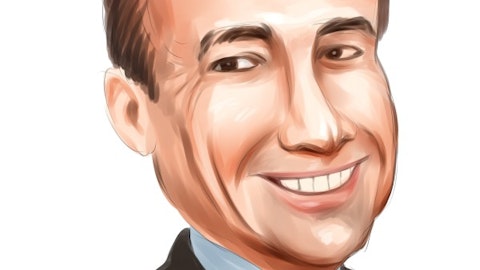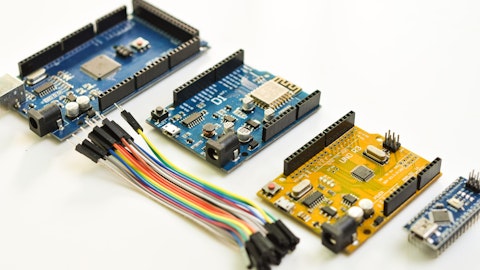In some cases, it’s efficiency in some cases, the fact that we don’t need a heat sink. In some cases, it’s because it is — you can get very low audio sands, which is necessary. But in many cases, it’s because it can handle much higher transient voltages again has this property that it doesn’t have a sharp breakdown voltage. So if you exceed the breakdown voltage for short periods of time, it does not damage the transistor, which is incredibly useful if you’re shipping products to places like India, where you have unstable grid, and so we are seeing a lot of interest in all these different areas. So I think the number of designs we are winning outside of mobile products, is higher than what we are winning within mobile. I think we talked about in the last conference call.
And Sandeep, maybe you can handle the gross margin.
Sandeep Nayyar: Yes. I think even though we are not totally certain on the revenue outlook for next year, we’ve done lots of different modeling and I think even with the different modeling, the best — I’m looking at around 53.5% for non-GAAP for next year also. Now long term, as I had talked about even in the Analyst Day that the mix go is favorable. But remember, the yen is at a very favorable place. So if you have to model out, you have to model that the yen would come back to some normal levels, it’s running at in the 140s versus the normal levels of 120. So as the mix goes up and the yen moves back I’ve always said we’ll be on the higher end of the model. And I think even for ’24, I think we’ll be somewhere around 53.5%, which is towards the higher end of our margin.
Operator: And your next question comes from the line of Matt Ramsey from TD Cohen.
Matt Ramsay: I’m trying to wrap my head around some of the commentary you gave around, I guess, a nnew normal” at around $150 million a quarter. And I wanted to dig into a little bit more as to what — how you guys built that. Was it historical sort of top down? Was it bottom up based on sort of design wins that you see and content that you have. I just kind of juxtapose that against, I think, the peak quarter was $150 million thereabouts in 2019 before the pandemic and things all got tight and things went higher. So I’m just trying to get my head around like sort of the pieces that you put together to get to that sort of new normal if that’s indeed what you’re sort of forecasting that it might be?
Balu Balakrishnan: Okay. So we have had several different ways of modeling it. I think finance has done their own model. Marketing has done their own model. Sales have done their own model. It’s based on multiple things. It is bottom-up and tops down. We have done both ways. In terms of bottom up, we have taken the — what we call a normal consumption of various markets before COVID and then said, okay, if you look at historically, the market SAM is increasing by this amount. And then on top of that, we have additional products and designs that add to that. So it’s not exact. But surprisingly, all three of them show that we should be at 150 a quarter, roughly speaking, other than, of course, everything else that’s going on like wars and geopolitics and so on.
So if you just take all of that away, that would be our trend line as of 2023 with growth further into the future. So it’s just a modeling exercise. It doesn’t take into account all the crazy things that are going on around the world.
Matt Ramsay: Thanks, appreciate it. Just a little bit shorter term. Sandeep, could you maybe break down the guidance for December by segment just given the amount of revenue dislocation here. I just want to make sure we’re all starting from the right place.
Sandeep Nayyar: Yes. I think what the decline you should see, as we talked about, the decline will be more significant in communication and computer but all four segments will decline.
Operator: Your next question comes from the line of Ross Seymore from Deutsche Bank.
Ross Seymore: You talked about the first quarter, you hope is going to go up, and I know it’s very difficult to predict these days. But if you’re going to end your channel inventory at 10 weeks, and that’s still at least one, if not two weeks above your target range, why wouldn’t we still have some burn there? And maybe even just seasonality to the extent that matters also being a headwind in 1Q?
Sandeep Nayyar: Yes. So, one of the things that we are expecting is a rebound. We talked about the cancellations in Q3 and Q4. And I think there will be a rebound on that. So that’s where I think the primary — that’s not — and that’s through direct sales, not through the channel. Also, if you really look at the level we are reaching in appliances, the channel inventory in appliances, we are hoping will by Q4 come down the revenue guidance that we have given, will really come down to normal levels. That’s my expectation in — and if you really think where the appliances have come down, and I’m just using that as one category, the level is now even below the 2019 level. So as Balu indicated, we are not certain of the total timing, but I’m hoping that in Q1, things like air conditioning start getting this build up, get more so in Q2 and then the rebound of this customer that I talked about, who at cancellations.
Those are the reasons that I think Balu’s saying will be better. What we are saying, we’re typically seasonally down negative 1% or 2%, but we’ll be better than that. So that’s why Balo said, we’ll be a little better than this quarter. And that’s a directional because of these couple of items.
Ross Seymore: Prior question asked about the gross margin. What about the OpEx side of things I know you’re pretty tight in the fourth quarter. How do you expect that in ’24?
Sandeep Nayyar: Yes. So this has been, as you can imagine, with all the inflation and everything has been a real challenge. And if you really look at our last four or five years, we’ve really tightened the belt, but we are at a point where we’ve got such exciting products in the pipeline. You’ve seen the announcement we had with GaN with the investments we are going to make there for automotive. We’ve got other investments for India and other places. And so — we have to make those investments. And that’s why for next year, I think you should — for modeling purposes, the expenses will grow 7% to 8% and from the current year level. If you really think what is really happening here, we cut our expenses nearly $7 million, $8 million this year.



